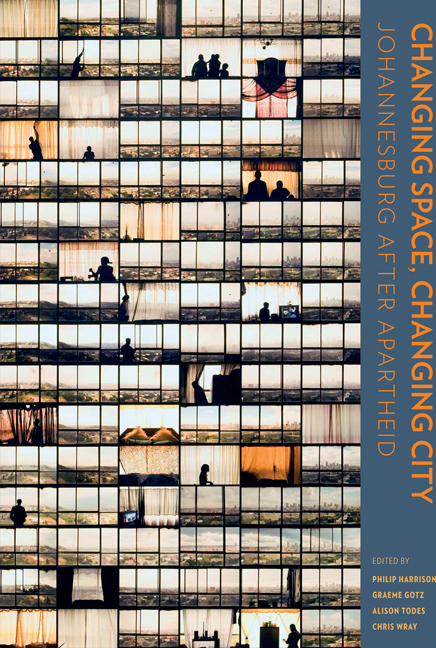Book contents
- Frontmatter
- Contents
- Preface
- Cartography
- 1 Materialities, subjectivities and spatial transformation in Johannesburg
- Section A The macro trends
- Section B Area-based transformations
- 12 Between fixity and flux: Grappling with transience and permanence in the inner city
- 13 Are Johannesburg's peri-central neighbourhoods irremediably ‘fluid’? Local leadership and community building in Yeoville and Bertrams
- 14 The wrong side of the mining belt? Spatial transformations and identities in Johannesburg's southern suburbs
- 15 Soweto: A study in socio-spatial differentiation
- 16 Kliptown: Resilience and despair in the face of a hundred years of planning
- 17 Alexandra
- 18 Sandton Central, 1969–2013: From open veld to new CBD?
- 19 In the forest of transformation: Johannesburg's northern suburbs
- 20 The north-western edge
- 21 The 2010 World Cup and its legacy in the Ellis Park Precinct: Perceptions of local residents
- 22 Transformation through transportation: Some early impacts of Bus Rapid Transit in Orlando, Soweto
- Section C Spatial identities
- Contributors
- Photographic credits
- Acronyms
- List of plates
- List of figures
- List of tables
- Index
15 - Soweto: A study in socio-spatial differentiation
from Section B - Area-based transformations
Published online by Cambridge University Press: 20 April 2018
- Frontmatter
- Contents
- Preface
- Cartography
- 1 Materialities, subjectivities and spatial transformation in Johannesburg
- Section A The macro trends
- Section B Area-based transformations
- 12 Between fixity and flux: Grappling with transience and permanence in the inner city
- 13 Are Johannesburg's peri-central neighbourhoods irremediably ‘fluid’? Local leadership and community building in Yeoville and Bertrams
- 14 The wrong side of the mining belt? Spatial transformations and identities in Johannesburg's southern suburbs
- 15 Soweto: A study in socio-spatial differentiation
- 16 Kliptown: Resilience and despair in the face of a hundred years of planning
- 17 Alexandra
- 18 Sandton Central, 1969–2013: From open veld to new CBD?
- 19 In the forest of transformation: Johannesburg's northern suburbs
- 20 The north-western edge
- 21 The 2010 World Cup and its legacy in the Ellis Park Precinct: Perceptions of local residents
- 22 Transformation through transportation: Some early impacts of Bus Rapid Transit in Orlando, Soweto
- Section C Spatial identities
- Contributors
- Photographic credits
- Acronyms
- List of plates
- List of figures
- List of tables
- Index
Summary
Soweto hardly needs an introduction. An iconic township, it's name reverberates through South African political history and is known internationally. The City of Johannesburg's report Remaking of Soweto provides a quantitative description that can serve as a prologue to this chapter:
Soweto's population is officially estimated at approximately 1.3 million, with between 600 000 and a million people in the township regarded as living in abject poverty. The township covers an area of approximately 150 km², just more than 9% of the 1 644 km² of the City of Johannesburg, and according to official sources, is home to 43% of the City of Johannesburg's population. It has an estimated density of approximately 8 667 people/km² compared to the 1 962 people/km² for the whole City area. (CoJ 2011: 2)
It is impossible to unravel the complex entanglement of society, politics, economics and environment that is continually shaping the production and reproduction of space across Soweto in this chapter. We do, however, provide a synoptic overview of spatial processes post-1994, and we locate this account within a tradition of writing on Soweto that goes back to the 1960s.
In common with earlier writers, we focus on the differentiated nature of Soweto's social and spatial landscape – Soweto cannot be spoken of in generic or generalised terms. We also try to provide a balanced and analytical perspective on more recent transformations in Soweto. The Remaking of Soweto is a glowing account of Soweto's makeover that celebrates Amos Masondo's ten-year stint as executive mayor of the City of Johannesburg. The report points to the transformation of Soweto as one of the considerable achievements of his administration. We do not dispute this claim but we do argue that there are diverse narratives and that the so-called ‘renaissance of Soweto’ is more partial and ambiguous than the report suggests.
In 1979 Phillip Frankel wrote that ‘Soweto displays many of the finer features of urban pathology in its endless rows of uniform 47 square metre houses, its unlighted, treeless and unpaved streets and in its rudimentary recreational outlets’ (1979: 50). It would be profoundly misleading to describe Soweto in similar terms today. There is no doubt that Soweto has experienced dramatic transformation. But, we must ask how equitable this change has been, and who in Soweto has benefited and who has not.
- Type
- Chapter
- Information
- Changing Space, Changing CityJohannesburg after apartheid, pp. 293 - 318Publisher: Wits University PressPrint publication year: 2014



